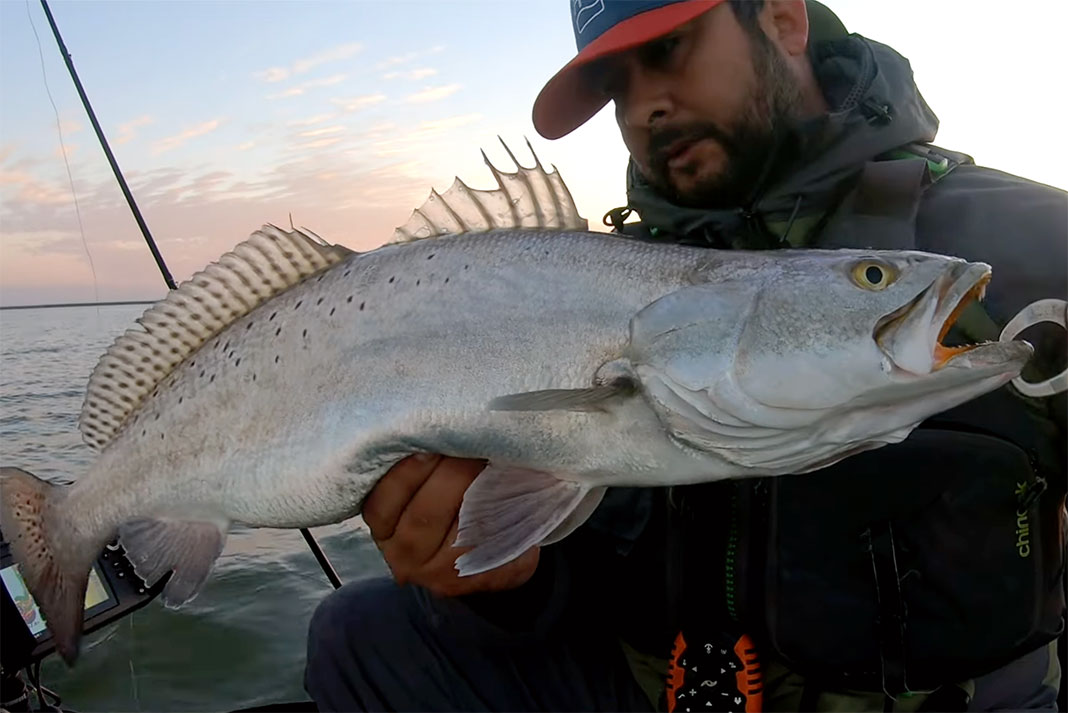When I think about speckled trout, a series of images flash through my mind. A postcard of an expansive marsh cut by tidal creeks and broad flats with calm water reflecting the sky. The iconic thump of a speckled trout striking a fishing lure. A gator trout jumping from the water, shaking its orange mouth, spray flying in all directions. The prayer I say when a papermouth trout pulls hard on the drag. And the final moment admiring the beautiful colors and patterns of this noble predator lying in my lap. From Texas to Virginia, speckled trout provide anglers a light tackle, finesse fishing challenge with a beautiful reward.
5 Expert Tips to Catch & Cook Speckled Trout
1 Spots, spots, spots
With their brilliant silver bellies, olive green spines, bright orange mouths and namesake black spots, speckled trout are the painter’s palette of the sea. Depending on local regulations, a keeper speckled trout is between 13 and 17 inches. A trophy trout exceeds 30 inches and eight pounds. Speckled trout prefer oyster reefs and seagrass beds in shallow bays or deep channels. Trout can survive in both salt and brackish water allowing the fish to spread throughout the mid-Atlantic, Southeast and Gulf of Mexico.

2 A True Predator
With eyes on top of the head and a turned-up mouth, speckled trout are sight hunters. Trout search the water column from the surface to the bottom for crustaceans and baitfish. Sometimes, trout hover and wait for the current to bring them a meal. Other times they actively hunt structure. Small trout primarily feed on small crustaceans. Medium-sized trout eat shrimp and small fish. Large specks feed almost exclusively on large mullet, pinfish, pigfish and menhaden.
3 Speck Hunt
Since speckled trout are active hunters, there are a variety of ways to target them. Three of the most popular tactics are topwater lures, twitch baits and popping corks.
When large speckled trout stage at ambush points, a suspended twitch bait maximizes the lure’s time in the strike zone. When trout move shallow, a topwater lure triggers a big yellow mouth to attack. In deeper water, use a popping cork to dangle a live shrimp or baitfish or a soft plastic imitation on a small jighead. Most speckled trout are caught on a ⅛- to ½-ounce jighead and three- to five-inch soft plastic worked off the bottom or retrieved steadily.
My favorite way to catch a giant trout is with a large live mullet, pigfish, pinfish or menhaden. It takes a lot of patience to fish for a big bite, but the trophy is worth the wait.
4 Pro Tip
In its arsenal of tricks, a speckled trout has a light bite, a paper-thin mouth and a head-shaking jump. To feel the bite, use braided fishing line and a sensitive rod. Keep your finger on the line to detect the slightest bump. Fighting a trout is a fine line between gently coaxing the fish without giving it time to pull the hook.
Keep a trout from pulling the hook by setting the drag light and gingerly working the fish to the boat. All you can do when a trout jumps out of the water and throws its yellow mouth through the air is hope the hooks are sharp and strong. A jighead with a wide-gap hook or a lure with light treble hooks is your best shot at staying attached to a trout.
5 Table Fare
Speckled trout have an exquisite light white meat requiring careful handling. Ice the fish as soon as you land it. Speckled trout are easy to fillet by running a sharp, thin blade down the backbone to separate the meat. Rinse off the tiny scales and leave on the skin. For a real treat, try speckled trout sushi.
Small speckled trout taste the same as a big one. To protect the species, we recommend releasing trout over 20 inches.
Spots for days. | Feature photo: Jason Arnold










That feller looks like he would bite back!
Speckled trout are a member of the drum family and should never be eaten raw because of parasites.